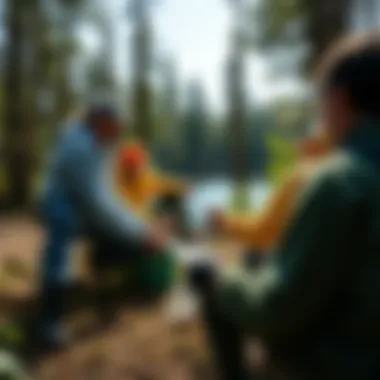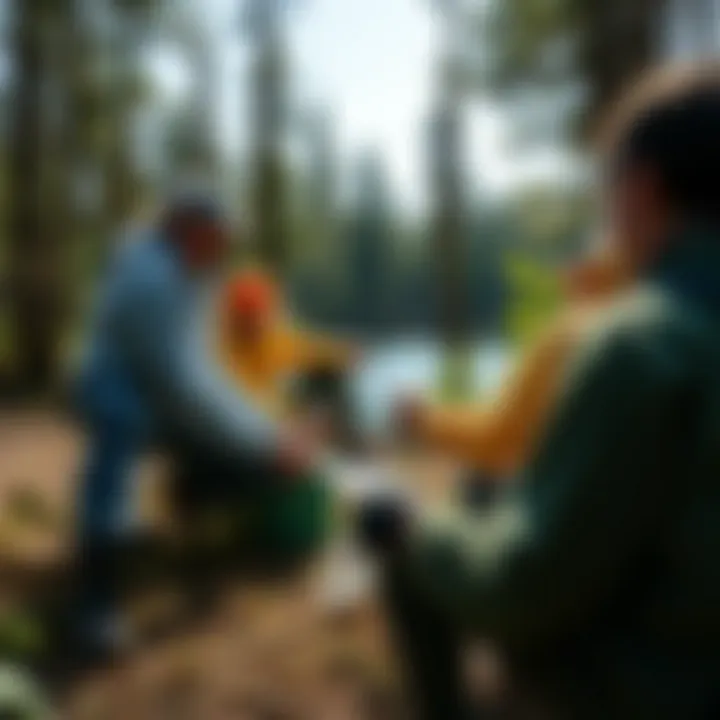Exploring Cherry Lake: Nature, Community, and Ecology


Intro
Cherry Lake stands as a beacon of ecological health, an area where nature thrives alongside responsive community efforts. It provides not just a habitat for diverse flora and fauna but also serves as a recreational oasis for locals and visitors alike. This article explores the depth of what Cherry Lake represents—from its ecological importance and recreational value to community engagement and stewardship. By closely examining these different aspects, we can appreciate not only the beauty of Cherry Lake but also the pressing need for sustainable practices in our woodland areas.
Forest Ecology and Biodiversity
Importance of Forest Ecosystems
Forest ecosystems are crucial for maintaining biodiversity and supporting various life forms. They act like the planet's lungs, absorbing carbon dioxide while releasing oxygen—truly an essential service. In Cherry Lake, the balance of these ecosystems can be seen through a rich tapestry of plant and animal life.
"Healthy forests not only support wildlife but also serve as a buffer against climate change and soil erosion."
They are foundational for overall ecological integrity, ensuring that species find suitable habitats to thrive. This interdependence among species creates a resilient ecological network that is not easily dismantled.
Flora and Fauna in Woodlands
Walking through the woodlands of Cherry Lake reveals a microcosm of life. The diverse plant species in the area range from towering oaks to delicate wildflowers. Their varied structures and growth styles provide numerous niches for wildlife. Some notable flora might include:
- Bald Cypress: Thrives in wetland areas and provides habitat for various bird species.
- Bluebell Flowers: Pop up in the spring, offering nourishment for pollinators.
Fauna in this region includes everything from deer and foxes to a multitude of avian species. Each plays a role in the ecosystem, whether through seed dispersal or predator-prey relationships, contributing to the overall health of the area.
Sustainable Forestry Practices
Techniques for Responsible Management
Sustainable forestry is more than just a buzzword; it's a commitment to preserving the integrity of our woodlands. Techniques employed in Cherry Lake can range from selective logging to maintaining buffer zones around water bodies. These practices ensure that while resources are utilized, the community remains mindful of ecological balance.
In managing Cherry Lake's forests responsibly, local authorities often focus on:
- Selective Cutting: Allows for tree regeneration and minimizes habitat disruption.
- Ecological Restoration: Focused on returning land to its natural state.
Certification Schemes and Standards
To ensure that forestry practices are sustainable, certification schemes like the Forest Stewardship Council (FSC) and Programme for the Endorsement of Forest Certification (PEFC) come into play. These organizations establish standards for responsible forest management that not only benefit the environment but also support local communities.
Such certifications guide consumers who seek to make environmentally conscious choices. They're crucial as they help direct market trends towards more sustainable options, impacting what is logged and how forestry operations are conducted.
Community Engagement and Stewardship
Role of Local Communities
The relationships that local communities have with their environment in Cherry Lake cannot be overstated. Community involvement often leads to greater awareness and investment in the sustainability of the area. Through initiatives like educational workshops, residents gain insight into effective woodland stewardship.
Volunteer Opportunities for Engagement
There are plenty of ways for community members to get involved and make an impact:
- Tree Planting Events: Often organized in the spring, engaging locals in hands-on restoration.
- Trail Maintenance Days: Ensuring that recreational areas remain accessible while preserving their natural beauty.
Engaging in these activities not only fosters a sense of community but also cultivates a collective responsibility toward stewardship, linking personal values with broader ecological goals.
Geographic Overview of Cherry Lake
Understanding the geographic overview of Cherry Lake is key to appreciating its natural beauty and ecological importance. This section provides a vital framework for the rest of the article, contextualizing its intricate relationship with the surrounding environment and human communities. Geographic factors shape the flora and fauna of the region, influence local climates, and determine accessibility for both residents and visitors alike. Recognizing these aspects offers insight into the challenges faced by this unique ecosystem and how, in turn, it supports biodiversity and community well-being.
Location and Accessibility
Cherry Lake is nestled in a picturesque spot, simmering in the heart of a vibrant landscape. It lies tucked away, not too far from urban centers but still a world away from the hustle and bustle. Getting there isn’t rocket science; visitors can access it via well-marked trails or via car from the nearest towns. Watch for signs that guide you, making the trip smooth and straightforward.
The accessibility of Cherry Lake plays an essential role in its community interaction. The fact that both residents and tourists can reach the lake easily fosters a connection with nature. However, with increased footfall, there also comes a responsibility to maintain the environment. The best of both worlds is hitting that sweet spot where human activity and nature’s need for preservation coexist harmoniously.
Physical Characteristics
Cherry Lake’s physical characteristics are a melodious blend of landforms and water features. The lake stretches across a considerable expanse, providing a vibrant habitat for a range of species. Banks lined with lush vegetation provide a natural refuge for wildlife, while the lake's clear blue waters shimmer like sapphires under the sun. To the west, rolling hills give way to granite outcrops that tell stories of geological history over millennia. These forms not only add to the scenic beauty but also serve functional purposes—bridging habitats and allowing for diverse ecosystems.
With an average depth that varies throughout the year, the lake’s water levels fluctuate, affecting plant and animal life. Aquatic systems are dynamic entities influenced by these physical traits. The result? An environment that naturally evolves, showing just how interconnected everything is at Cherry Lake.
Surrounding Flora and Fauna
The scrumptious tapestry of life surrounding Cherry Lake is nothing short of astounding. From towering trees to delicate wildflowers, the area's biodiversity flourishes thanks to a robust mix of ecosystems. You might spot oaks, pines, and birches standing like silent sentinels, aged yet striking. In springtime, an array of wildflowers bursts into bloom, painting the landscape in vibrant hues.
Fauna here is as captivating as flora. The rich habitats support numerous species, including deer, raccoons, and countless bird species that call this place home. Some birds, like the majestic bald eagle, soar high above, while others flit between branches, creating a symphony of sounds. This rich tapestry not only beautifies the landscape but also forms an essential network within the ecosystem, supporting conservation efforts.
"Biodiversity is not just a word; it's the essence of our ecological system at Cherry Lake, reminding us of the delicate balance that sustains life."
Understanding the geographical and ecological nuances at Cherry Lake deepens our appreciation for both nature and community interactions. This overview serves not just to inform but to inspire responsible stewardship and awareness of how intertwined our lives are with nature.
Ecological Significance


The ecological significance of Cherry Lake extends far beyond its picturesque views and recreational opportunities. This body of water plays a critical role in preserving the natural balance of the region's ecosystem. It provides vital resources and services that sustain both the environment and the local communities. Understanding these intricacies helps emphasize the importance of continued stewardship and preservation efforts.
Biodiversity and Habitat Conservation
At the heart of Cherry Lake's ecological role is its biodiversity. The lake serves as a habitat for various species, ranging from aquatic life such as fish and amphibians to an array of birds and terrestrial animals that rely on this ecosystem. Notably, species like the Northern Pike and Great Blue Heron have made the area their home, contributing to a rich tapestry of life. Each species, whether keystone or less prominent, plays its part in maintaining the health of the surrounding environment.
Conservation efforts focused on this biodiversity are critical. By protecting these habitats, not only do we safeguard the flora and fauna that dwell in and around Cherry Lake, but we also ensure the continuation of essential ecosystem services, such as pollination, water filtration, and nutrient cycling.
"Biodiversity is the cornerstone of ecosystem stability; every species has its role in the grand scheme of nature."
Water Quality and Aquatic Ecosystems
The clarity and quality of water at Cherry Lake are paramount to its health and the health of its ecosystems. Water quality affects not just the aquatic organisms thriving within but also influences terrestrial species that depend on it indirectly. Factors such as nutrient levels, contamination, and temperature can dictate the health of fish populations or the richness of algal blooms.
Regular monitoring of water quality is essential to manage pollutants and maintain the delicate balance of the ecosystem. For instance, controlling runoff from nearby agricultural lands can help prevent nutrient overload, which can lead to harmful algal blooms that disrupt aquatic life. Healthy water systems also ensure that recreational activities, like fishing or swimming, remain safe for local residents and visitors alike.
Climate Regulation and Carbon Sequestration
Cherry Lake plays a significant role in climate regulation. The vegetation surrounding the lake, including wetlands and forests, acts as major carbon sinks. Trees absorb carbon dioxide from the atmosphere, mitigating climate change impacts. The wetlands, in particular, store vast amounts of carbon in their saturated soils, effectively sequestering it away from the global carbon cycle.
The interplay between the lake and its surrounding environments creates microclimates that can further cushion the effects of climate variability. This is especially important as we witness more extreme weather patterns. Conservation of this landscape thus becomes an investment not just in local biodiversity but in building resilience against climate change.
In summary, understanding the ecological significance of Cherry Lake involves a layered exploration of biodiversity, water quality, and climate regulation. Each aspect intertwines with the others, creating an intricate web that both supports and sustains the life it harbors. Protecting these vital elements is integral not only for the health of the lake, but also for the communities that depend on it.
Cultural and Historical Context
Understanding the cultural and historical context of Cherry Lake is essential to appreciate the deep-rooted connections that local communities have established with this natural landscape. The interplay between the land’s ecology and the traditions of its inhabitants has shaped a unique narrative that is crucial for ecological awareness and conservation. Moreover, by recognizing historical practices, we gain insight into the dynamic relationship between nature and society over time.
Indigenous Connections to the Land
The Indigenous communities around Cherry Lake have fostered a rich tapestry of connection with the land, dating back thousands of years. For these groups, the lake is not just a body of water but a living entity with which they share mutual respect and obligation. This connection encompasses a wealth of traditional ecological knowledge—insights passed down through generations regarding the flora and fauna that populate the area.
Key Factors of Indigenous Connection:
- Spiritual Significance: Many Indigenous tribes view the land and water as sacred, embedded with stories and teachings fundamental to their cultural identity.
- Sustainable Practices: These communities have long practiced sustainable harvesting methods, ensuring that resources are available for future generations.
- Cultural Ceremonies: Rituals and festivals are often held at or near the lake, reinforcing community bonds and celebrating the natural cycles evident in the ecosystem.
Historical Uses of Cherry Lake
Looking back at the historical uses of Cherry Lake paints a vivid picture of human interaction with nature throughout the ages. Initially, the area served as a vital resource—providing food, water, and materials for shelter. Over time, these uses evolved, influenced by technological advancements and shifting societal needs.
In the early days, the lake was predominantly utilized for subsistence activities, including fishing and gathering. As towns developed nearby, the recreational potential of the lake started to come to light. Cherry Lake transformed into a cherished destination for swimming, picnicking, and seasonal festivals, drawing local residents and visitors alike. The economic implications were significant as well, with small businesses evolving to cater to tourists.
Historical Highlights:
- 19th Century: Cherry Lake gained recognition as a health retreat, attracting city dwellers seeking cleaner air and natural remedies.
- Twentieth Century: The introduction of recreational infrastructure changed how people engaged with the lake, amplifying its role as a leisure destination.
Modern-Day Cultural Practices
Fast forward to the present, and Cherry Lake continues to be a focal point for cultural practices, bridging tradition with contemporary life. Community gatherings, environmental education programs, and local arts initiatives coalesce, fostering a vibrant cultural scene that honors the past while looking to the future.
Cultural Aspects Today:
- Art and Nature Interplay: Local artists often draw inspiration from the lake's serene landscapes and biodiversity, showcasing their work in galleries and festivals.
- Educational Workshops: Numerous organizations carry out workshops centered on conservation, connecting younger generations with traditional knowledge about land stewardship.
- Civic Engagement: Community projects frequently engage locals in conservation efforts, instilling a sense of ownership and responsibility toward maintaining Cherry Lake for future generations.
"The natural resources offered by Cherry Lake are woven into the very fabric of our community, impacting every aspect of our daily lives and cultural practices."
In essence, the cultural and historical context of Cherry Lake is not merely a backdrop but an active influence on its ecological health and community dynamics. Understanding this narrative enables a deeper appreciation and commitment to preserving this integral part of the landscape.
Recreational Opportunities
Recreational activities at Cherry Lake serve not just as a means of enjoyment and relaxation but also enhance individual well-being while fostering a deeper connection to nature. This section outlines the various activities available, particularly highlighting how they contribute to both personal health and community engagement. People visiting the lake can find numerous avenues to immerse themselves in the natural environment, making it a vital aspect of local culture and ecology.
Hiking and Nature Trails
Hiking around Cherry Lake is more than just a pastime; it's a journey that intertwines physical fitness with an exploration of the region's rich biodiversity. The hiking trails meander through lush forests and along scenic lakefronts, offering various difficulty levels that cater to both seasoned hikers and casual nature walkers.
As you navigate these paths, you'll encounter local flora and fauna, providing a tangible sense of the ecosystem at play. Trail signage, often crafted by local artists, adds an educational layer to the experience, detailing information about the different species one might encounter. Some key points to note about hiking at Cherry Lake include:
- Health Benefits: Hiking promotes cardiovascular fitness, strengthens muscles, and enhances mental health by reducing stress.
- Accessibility: Many trails are designed to accommodate a wide range of mobility needs, ensuring everyone can participate in this enriching experience.
- Wildlife Sightings: You might spot deer, various bird species, or even small mammals, making each hike unique.
All these factors make hiking an essential aspect of what Cherry Lake has to offer, weaving together community, ecology, and personal wellness.
Fishing and Water Sports
Fishing at Cherry Lake is a cherished local tradition. The lake supports a variety of fish species, including bass, trout, and panfish. Anglers of all skill levels frequent its shores to enjoy peaceful fishing experiences.
- Community Events: Periodic fishing tournaments draw enthusiasts from near and far, fostering camaraderie and competition.
- Skill Development: Local guides offer workshops, teaching techniques that can enhance fishing skills and promote responsible practices.
- Conservation Efforts: Understanding fishing regulations is crucial, as they help maintain fish populations and ensure the sustainability of aquatic ecosystems.
Water sports, on the other hand, are popular, with opportunities for kayaking, paddleboarding, and sailing. These activities not only enhance recreational fun but also encourage physical activity, promoting a healthy lifestyle and a vibrant, active community by the water.
Camping and Outdoor Education


Camping around Cherry Lake provides a perfect escape from the hustle and bustle of daily life. The campground facilities are equipped with both basic and advanced amenities, accommodating everyone from families with children to seasoned adventurers.
Outdoor education programs held in the campground aim to connect visitors with nature. They range from basic survival skills to environmental conservation workshops, making camping a comprehensive educational experience. Important aspects to consider:
- Nature Centers: Many campsites include a nature center where visitors can engage in workshops, learn about local wildlife, and even participate in guided night hikes, which are often a crowd favorite.
- Inclusivity: Campgrounds offer various sites, including tent sites and cabins, allowing for all groups to find accommodation that suits their needs.
- Cultural Programs: Ties to local history and storytelling sessions give campers a sense of place, rooting their experience in the community’s narratives.
Cherry Lake thus acts as a gateway not just for leisure but also for learning and connecting with the environment, emphasizing the importance of outdoor stewardship. As the community grows alongside these recreational opportunities, the emphasis on sustainability ensures Cherry Lake's natural beauty continues for generations to come.
Economic Impact on Local Communities
The economic impact on local communities surrounding Cherry Lake is a critical aspect of its multifaceted nature. These communities thrive not just from the natural resources that the lake offers, but also from the diverse recreational and tourism activities it supports. The engagement of residents and businesses in promoting and preserving Cherry Lake has led to sustained economic opportunities that benefit both the environment and the local economy. Understanding this relationship is fundamental for stakeholders and conservationists to foster a vision of responsible coexistence with nature.
Tourism and Recreation Industry
Tourism plays a central role in boosting the economy around Cherry Lake. Visitors flock to the area to experience its natural beauty, engage in outdoor activities, and immerse themselves in the community culture. Popular recreational pursuits include hiking on the scenic trails, fishing in serene waters, and participating in water sports. Such activities inject capital into local businesses, ranging from hotels and restaurants to equipment rental shops and tour guides.
A study indicates that areas like Cherry Lake, rich in biodiversity and recreational prospects, can see a significant increase in foot traffic, especially during peak seasons. The thriving tourism industry further encourages local entrepreneurs to establish eco-friendly businesses, thus promoting sustainability while catering to visitors.
"When people explore our lake, they often leave with not just memories but also a connection to our community. That connection translates into economic benefits for us all."
Sustainable Practices in Local Businesses
Sustainability is more than just a buzzword; it’s a practice that, when integrated into local business strategies, can yield considerable economic benefits. Companies around Cherry Lake are increasingly adopting practices that protect the ecology while still turning a profit. For instance, local farms might utilize organic farming techniques and avoid harmful pesticides that could endanger the aquatic systems. This not only ensures a healthy environment but also often leads to a premium on goods sold to eco-conscious consumers.
Moreover, businesses that embrace sustainability attract more visitors—people are keen to partake in experiences that bolster their ethical considerations. By hosting workshops on conservation, promoting local artisans who use recycled materials, and engaging in community-led environmental initiatives, these businesses enhance their reputations and profitability, driving positive economic outcomes.
Job Creation and Economic Resilience
Jobs generated around Cherry Lake encompass a spectrum that goes beyond traditional sectors. The recreational and tourism industries provide numerous opportunities—from park rangers and tour guides to hospitality staff and environmental educators. Importantly, these jobs often resonate with community values, as many are filled by local residents who have a vested interest in preserving the natural beauty of the area.
Resilience in local economies is another critical factor, particularly in challenging times. When the community rallies around Cherry Lake, it fosters a sense of collective identity and economic security. Events such as local fairs, environmental clean-up drives, or educational workshops not only create jobs but reinforce networks among residents. These connections serve as a safety net, allowing communities to bounce back more effectively from economic downturns or environmental crises.
This synergistic relationship between economic output and conservation work demonstrates that community stewardship can lead to both ecological and economic prosperity, ensuring that Cherry Lake remains a thriving hub for both nature and society.
Challenges to Conservation Efforts
The journey of preserving Cherry Lake doesn’t come without its hurdles. Understanding the challenges to conservation efforts is essential, as it highlights the obstacles that exist in maintaining this natural haven for future generations. These challenges can be multi-dimensional, impacting not just the ecology but the community as well. Addressing them requires a concerted effort from various stakeholders, including local residents, environmental experts, and policymakers. Here’s a closer look at the specific challenges that stand in the way of effective conservation and what is being done to tackle them.
Environmental Threats and Pollution
One of the most pressing issues that Cherry Lake faces is the lingering threat of pollution and environmental degradation. Various sources contribute to this battered state, including run-off from nearby agricultural activities, urban development, and even littering by visitors. Water quality is of paramount importance, as it affects aquatic life and overall ecosystem health. Pollutants can lead to oxygen depletion, negatively impacting fish populations and other aquatic organisms.
To combat these issues, there has been a push to implement stricter regulations on agricultural practices and develop buffer zones along lakeshores. Monitoring programs also play a crucial role. Local conservation bodies have been stepping up efforts to keep tabs on water quality, undertaking regular assessments and working to educate the public on the impacts of pollution. Through these measures, there is hope for mitigating some of the adverse effects that threaten this natural resource.
Invasive Species Management
Invasive species pose a unique challenge that can easily tip the delicate balance of the ecosystem at Cherry Lake. Species such as the Eurasian wattermilfoil and the Asian carp are known to disrupt local biodiversity and food chains. Not only do these invaders compete with native species for resources, but they can also alter habitats drastically, making it hard for indigenous wildlife to thrive.
Strategies to manage invasive species have been varied and, at times, innovative. One effective measure has been the introduction of biological controls, such as promoting the populations of native predators that help keep these invaders in check. Furthermore, active removal efforts like localized harvesting or manual removal have been employed by dedicated volunteers and conservation organizations. Community education initiatives are equally important, helping residents identify and avoid contributing to the spread of these troublesome species.
Community Engagement in Conservation
A cornerstone of successful conservation efforts is community engagement. The residents around Cherry Lake are not just passive observers; they play an essential role in the stewardship of this area. Community involvement fosters a sense of ownership that can lead to sustainable practices and increased awareness of ecological issues.
Local organizations and governmental bodies have taken steps to directly involve community members through volunteer initiatives, workshops, and conservation easements. These programs don’t just provide educational resources but also empower individuals to make a tangible impact. One successful venture has been the establishment of community clean-up days, which address not only litter but also foster connections among residents who share a common goal—preserving the beauty and health of Cherry Lake.
"A community engaging in conservation is a powerful force that can challenge threats and pave the way for lasting ecological health."
Efforts to involve the community in conservation will ultimately yield benefits that extend beyond the lake itself. As citizens become more invested in their environment, a collective effort emerges that can advocate for better policies and practices, ensuring Cherry Lake remains a vital ecological gem for years to come.
Community Initiatives and Stewardship
Community initiatives and stewardship play an essential role in ensuring the vitality of Cherry Lake while fostering a strong bond between residents and their natural environment. The collective efforts of community members drive conservation endeavors, educate the public, and amplify engagement with local ecosystems. Understanding how these elements intertwine is pivotal as we explore the broader implications for ecological resilience and community-building.
Local Engagement in Conservation
Local engagement in conservation is not just a noble idea; it's a lifeline for ecosystems like those surrounding Cherry Lake. Residents often organize clean-up drives and tree-planting events, creating a ripple effect that nurtures both nature and social cohesion. These activities foster a sense of ownership; when locals roll up their sleeves and dig into the soil, they invest in their community's future.
For instance, a recent initiative focused on reviving the shoreline ecosystem has seen volunteers work side by side with biologists. They planted native vegetation, which benefits wildlife while also improving water quality. The direct benefits of these endeavors are two-fold: not only do they boost the health of the environment, but they also strengthen community ties, creating memorable experiences and developing environmental advocates among participants.
Educational Programs and Workshops
Education is the backbone of effective conservation practices. Various programs and workshops are conducted yearly in Cherry Lake to enlighten community members about local ecosystems and sustainable practices. These educational efforts often bring together experts—from ecologists to environmentalists—who share their knowledge with individuals eager to learn.
Workshops on topics such as wildlife ecology, responsible fishing practices, and sustainable forestry encourage small but influential shifts in behavior. For example, participants often emerge from these sessions with a deeper appreciation for the biodiversity around Cherry Lake. By emphasizing practical tips and hands-on experiences, like conducting water quality tests, attendees gain first-hand insights into maintaining ecological health. This type of learning makes the knowledge personal and applicable.
Collaborative Conservation Projects
Collaboration is at the heart of successful conservation efforts. Various stakeholders, including local government, non-profit organizations, and resident volunteers, come together for collaborative projects aimed at addressing specific ecological concerns in Cherry Lake. These projects often illustrate the power of teamwork in tackling complex environmental issues.


One notable example involves multi-organizational partnerships focused on managing invasive species threatening local habitats. By pooling resources and expertise, partners manage to monitor and control invasive plant growth effectively, ensuring the protection of native species. Initiatives like these don’t just safeguard the environment; they also enhance community relations, bringing together diverse perspectives in a unified approach toward a common goal.
Ultimately, the interconnection among local engagement, educational endeavors, and collaborative efforts demonstrates that community initiatives and stewardship are not merely supplementary but foundational for Cherry Lake's conservation narrative. By actively participating in the stewardship of their environment, community members not only protect their natural resources but also cultivate an enduring sense of responsibility and connection to the land.
"When communities engage with and participate in conserving their local environments, they create a self-sustaining cycle of stewardship that benefits both people and nature."
Resources:
Innovations in Forestry Practices
Innovations in forestry practices are crucial in today's rapidly changing environmental landscape. These practices aim not just to maximize timber production but also to maintain ecological balance and community well-being. As the pressures of climate change and human development intensify, the focus on sustainable methods in managing forest resources has never been more pressing. This section delves into various innovative techniques that can transform traditional forestry into a more holistic and community-focused approach.
Sustainable Logging Techniques
Sustainable logging techniques are the backbone of modern forestry. Unlike the ye olde practices that often led to deforestation and habitat destruction, these methods prioritize responsible resource management. For instance, selective logging allows for the harvest of certain trees while preserving entire ecosystems. This practice maintains biodiversity and minimizes the ecological footprint on the forest.
Moreover, it includes practices such as Reduced Impact Logging (RIL), where careful planning and execution seek to minimize damage to surrounding trees and soils. Some notable benefits of these sustainable logging techniques include:
- Improved Biodiversity: Managing tree species variably promotes a healthier ecosystem.
- Enhanced Soil Quality: Careful operations protect the nutrient-rich layers of the soil.
- Economic Viability: Sustainable methods can yield long-term economic benefits through perpetual resource availability.
The integration of these practices contributes significantly to a future where forestry serves both economic and ecological purposes.
Forest Restoration and Management
Forest restoration and management are complementary processes aiming to rehabilitate degraded areas, ensuring that ecological integrity is restored. This multifaceted approach adapts to local conditions, addressing previous land-use impacts while fostering native species recovery. Practical restoration efforts might include reforestation initiatives, where trees are planted to rehabilitate areas that have been logged or suffered environmental damage.
Additionally, managing existing forests through continuous monitoring ensures that they remain resilient to pest infestations and climate stressors. Importantly, engaging with local communities in these practices not only enhances the effectiveness of restoration efforts but also promotes stewardship and ownership amongst residents.
Key strategies in forest restoration and management are:
- Native Species Planting: This restores natural habitats and provides essential support for local wildlife.
- Control of Invasive Species: Regularly monitoring and controlling invasive plants protects biodiversity.
- Community Education: Workshops and programs to inform and engage locals about sustainable practices foster a culture of conservation.
By blending scientific approaches with community involvement, restoration becomes a powerful tool in achieving both ecological balance and social engagement.
Technology in Forestry: A Growing Trend
Technological advancements are a game changer in forestry, offering various tools to enhance both productivity and sustainability. Innovations like drone technology allow for aerial surveys of vast forests, identifying growth patterns, pest outbreaks, or diseases with remarkable efficiency, thus enabling rapid response.
Moreover, Geographic Information Systems (GIS) facilitate better decision-making by providing spatial data that helps in planning logging activities, monitoring forest health, and managing resources efficiently. This tech-savvy approach not only optimizes timber production, but also prioritizes sustainability and conservation.
Some notable technologies reshaping forestry include:
- Remote Sensing: It provides real-time updates on forest conditions and dynamics.
- Automated Logging Equipment: Machines can harvest trees more accurately, reducing waste.
- Data Analytics: Tools analyze growth patterns, informing management decisions to enhance production and sustainability.
By leveraging technology, the forestry sector can not only meet economic needs but also embrace a stewardship model that aligns closely with conservation goals.
"Embracing innovations in forestry is not just about efficiency; it's about fostering a sustainable relationship with our land and communities, securing a future worth preserving."
This innovative spirit in forestry practices not only reflects a shift towards sustainability but also indicates a deeper commitment to our ecological and community responsibilities.
Future Directions for Cherry Lake
Looking ahead, the importance of defining Future Directions for Cherry Lake cannot be overstated. This section serves as a compass, guiding us towards establishing a sustainable relationship with this vital ecosystem. It melds together the aspirations of the local community, the imperatives of environmental stewardship, and the needs for recreational and economic development. These three strands weave into a robust framework, ensuring Cherry Lake remains a beacon of nature for future generations.
A balanced approach to conservation goals must be taken alongside enhancing public access and engagement efforts. With carefully laid-out monitoring and evaluation strategies, stakeholders can assess the effects of implemented initiatives, adapting as necessary to changing environmental and community dynamics.
> "Future directions must be driven by both ecological and community needs, ensuring a holistic approach to stewardship."
Long-Term Conservation Goals
Establishing Long-Term Conservation Goals is pivotal in ensuring the resilience and health of Cherry Lake. These goals should focus on several key aspects, including:
- Enhancing Biodiversity: Maintaining and expanding the variety of species found within the area ensures a balanced ecosystem. Strategies may include habitat restoration and specific conservation programs for endangered species.
- Mitigating Climate Change Impacts: Through reforestation efforts and implementing more effective land-use practices, mitigation measures can help lower carbon footprints and enhance the resilience of local habitats.
- Sustainable Water Management: Safeguarding water quality is crucial for both drinking and wildlife. Conservation initiatives could involve setting limits on pollution and promoting practices that enhance water cycles.
These goals require the collaboration of local governments, non-profits, businesses, and the community alike, fostering a culture of involvement and responsibility.
Enhancing Public Access and Engagement
Enhancing Public Access and Engagement is essential in nurturing a sense of ownership among residents and visitors alike. It's not just about getting people to visit Cherry Lake; it’s about forging lasting connections between the community and this natural resource.
Consider the following approaches to bolster public access:
- Creating Educational Programs: Establishing workshops, guided nature walks, and information centers can enlighten visitors on the ecological significance of Cherry Lake and promote stewardship.
- Developing Infrastructure: Improving trails, picnic areas, and signage will facilitate better access while ensuring sustainability. A thoughtfully designed landscape accommodates both nature and human enjoyment.
- Community Events: Organizing festivals, clean-ups, and volunteer days can engage the community, making them feel directly involved in the stewardship efforts.
Each of these actions lays a foundation for increased engagement and deeper appreciation of Cherry Lake’s offerings, ensuring responsible use of its resources.
Monitoring and Evaluation Strategies
To navigate the ever-changing landscape of ecological management, Monitoring and Evaluation Strategies must be integral to any plan concerning Cherry Lake. These strategies will ensure that the initiatives undertaken produce the desired outcomes and adapt when necessary.
Key strategies may include:
- Regular Biodiversity Assessments: Conducting periodic surveys of flora and fauna helps gauge the health of the ecosystem.
- Water Quality Monitoring: Consistently testing water samples can reveal trends in pollution or changes in aquatic life, informing necessary interventions.
- Community Feedback Mechanisms: Establishing methods for residents and visitors to provide feedback ensures that community voices are included in conservation decisions.
By implementing these monitoring systems, ongoing evaluation can be performed effectively, prompting revisions to strategies when challenges arise or new opportunities for improvement present themselves. Through vigilance and adaptive management, Cherry Lake can thrive as a crucial nexus of nature, ecology, and community.















